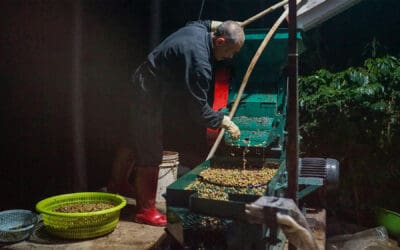As a local Barista Champion, Sonia Reyes’ choice between a coffee blend or single-origin bean carries the weight of gospel in the espresso world.
But what’s fascinating isn’t just what she chooses – it’s why she chooses it.
The Hidden Pattern Behind Great Espresso
In coffee shops across across Canada, a quiet revolution is brewing. For decades, espresso meant dark-roasted blends – reliable, consistent, and safe. Then came the single-origin movement, promising transparency and unique flavour experiences.
“Think of coffee beans like musical instruments,” explains James Hoffmann, former World Barista Champion and respected coffee author. “Blends are like orchestras, while single-origins are solo performances. Both can be beautiful, but they serve different purposes.”
This simple comparison unlocks a deeper truth about espresso that many of us miss.
The Science Behind Your Shot
When pressurized water forces its way through perfectly ground coffee, it creates a concentrated beverage with over 800 aromatic compounds – more than wine. This complexity explains why the blend versus single-origin choice matters so much.
Here’s what research from the Specialty Coffee Association reveals:
Blends typically offer:
- More balanced flavour profiles
- Greater consistency between batches
- Complementary taste characteristics
- Year-round availability
Single-origins typically deliver:
- More distinctive flavour notes
- Clearer representation of terroir
- Seasonal flavor experiences
- Traceability to specific farms
The Golden Crown: Crema Dynamics
That caramel-coloured foam floating atop your espresso – the crema – tells a fascinating story about your beans. And here’s where blends truly shine.
The perfect crema, according to Sonia, “should be persistent, tiger-striped, and just the right thickness.”
Research published by Navarini and Illy identifies how blends crafted specifically for espresso often produce superior crema because they combine beans with complementary properties:
Robusta Components: When added at 10-20% to a blend, robusta beans significantly increase crema production due to their higher lipid and carbohydrate content. This explains why many Italian-style espresso blends incorporate some robusta.
Bean Freshness Interplay: A common blending trick involves combining beans at different post-roast stages. Baristas I know agree, fresh beans produce more CO2, creating abundant crema, while slightly rested beans contribute better flavour stability. A thoughtful blend balances both.
Visual Texture Variation: Next time you pull shots of a blend versus single-origin, observe the crema closely. Single-origins typically produce more uniform crema, while well-designed blends often display the prized “tiger striping” effect – darker streaks flowing through golden foam.
The Unexpected Advantage
The head roaster at one of my favoured local coffee houses, discovered something surprising when analyzing customer preferences. “People who try single-origin espressos often become more adventurous coffee drinkers overall,” he says. “They start asking different questions and exploring coffee more deeply.”
Bear this in mind and watch how your tastes deepen.
This revelation suggests the choice between blends and single-origins isn’t just about taste – it’s about the journey we take as coffee lovers.
The Crema Test
Here’s a simple experiment baristas use to evaluate espresso quality: the “crema dissipation test.” Single-origin espressos often show faster crema breakdown, while well-crafted blends maintain their crema longer. This isn’t just visual – it affects how flavours release as you sip.
Watch how the crema behaves in the first 30 seconds after extraction. You’ll find it’s like watching a preview of how the flavours will unfold on your palate.
What The Pros Do
I asked five champion baristas about their competition choices. Three chose carefully crafted blends, while two selected exceptional single-origin beans. But all agreed on one crucial point: the quality of the coffee matters far more than the category.
Try This At Home: The 3-Day Experiment
Want to discover your preference? Try this simple experiment:
Day 1: Purchase both a quality espresso blend and single-origin bean (look for “espresso roast” on the single-origin)
Day 2: Prepare each as espresso using identical parameters:
- 18g coffee
- 36g liquid output
- 25-30 second extraction
- Take notes on flavor, body, and aftertaste
- Crema Assessment: Observe crema thickness, color, and how long it lasts
Day 3: Try both coffees again, but this time as milk drinks
- Which one cuts through milk better?
- Which creates a more harmonious overall experience?
- Notice how different crema characteristics affect milk integration
Pro Tip: For an advanced test, try the “spoon test” – gently place a spoon of sugar on the crema and time how long it takes to sink. Robust crema from quality blends often supports the sugar longer, indicating better emulsification of coffee oils.
The Middle Path
What many coffee professionals don’t advertise is that the line between blends and single-origins is blurring. Some of today’s most exciting espressos are:
- Single-origin beans from multiple harvests
- Micro-lot blends from neighbouring farms
- Single-variety blends from different regions
The future isn’t about choosing sides. It’s about understanding that good espresso depends on intention, not categories.
Your Next Step
Whether you choose blends or single-origins depends on what you (or your friends) value most in your espresso experience:
- For consistency and balance with stable crema: Quality blends remain your best bet
- For exploration and unique experiences: Rotate seasonal single-origins
- For the best of both worlds: Keep a reliable blend as your base and experiment with single-origins on the side
When evaluating blends specifically for crema quality, look for these clues on packaging:
- “Crafted for espresso” typically indicates attention to crema development
- “Contains robusta” suggests enhanced crema production
- “Post-blend” means beans were roasted separately before blending, often creating more complex crema
Remember, the best espresso is ultimately the one that brings you joy – regardless of what’s printed on the bag.
For more on this subject, be sure to subscribe to The Coffee Authority Weekly. Share your experiences and learn from the community.



0 Comments